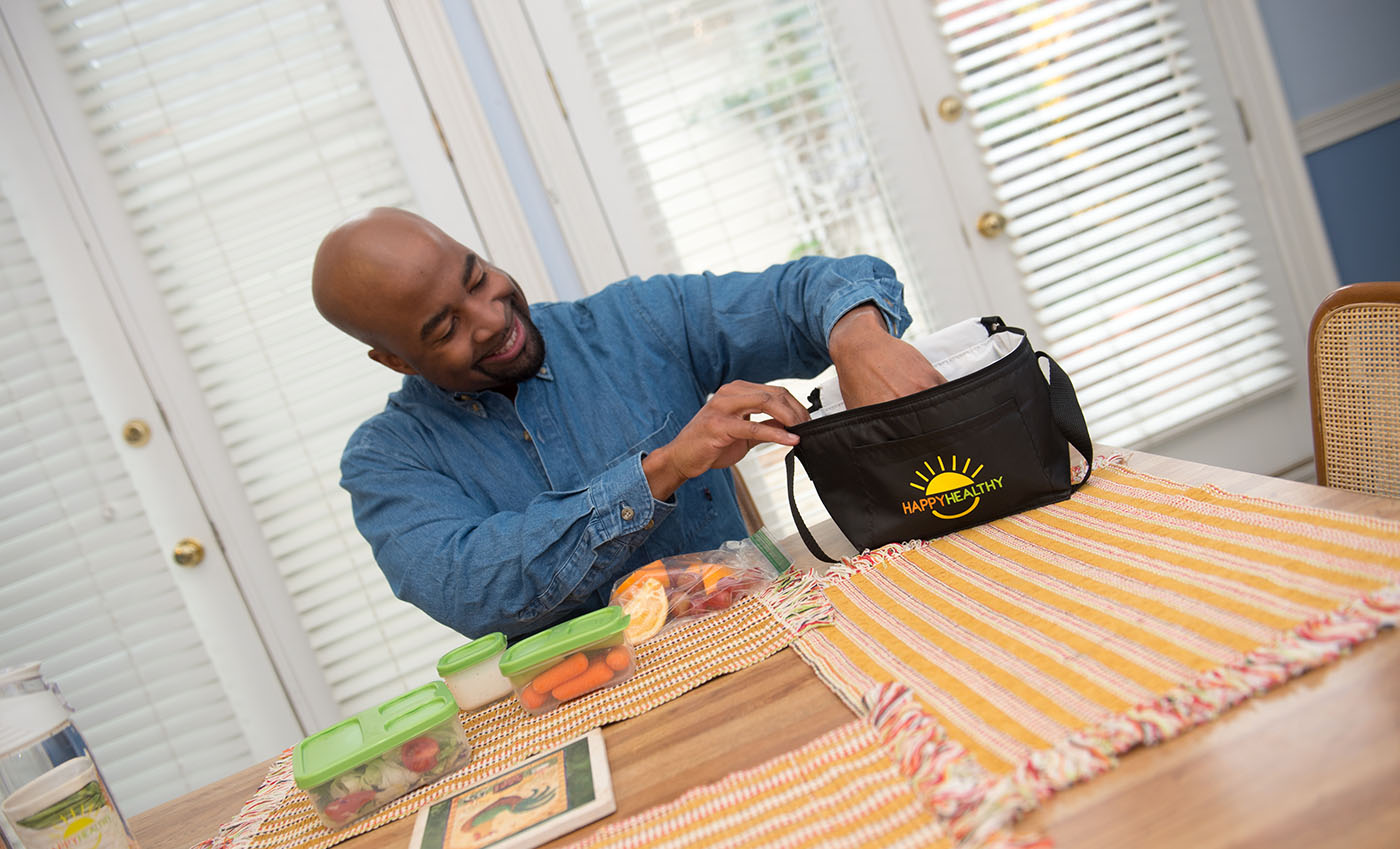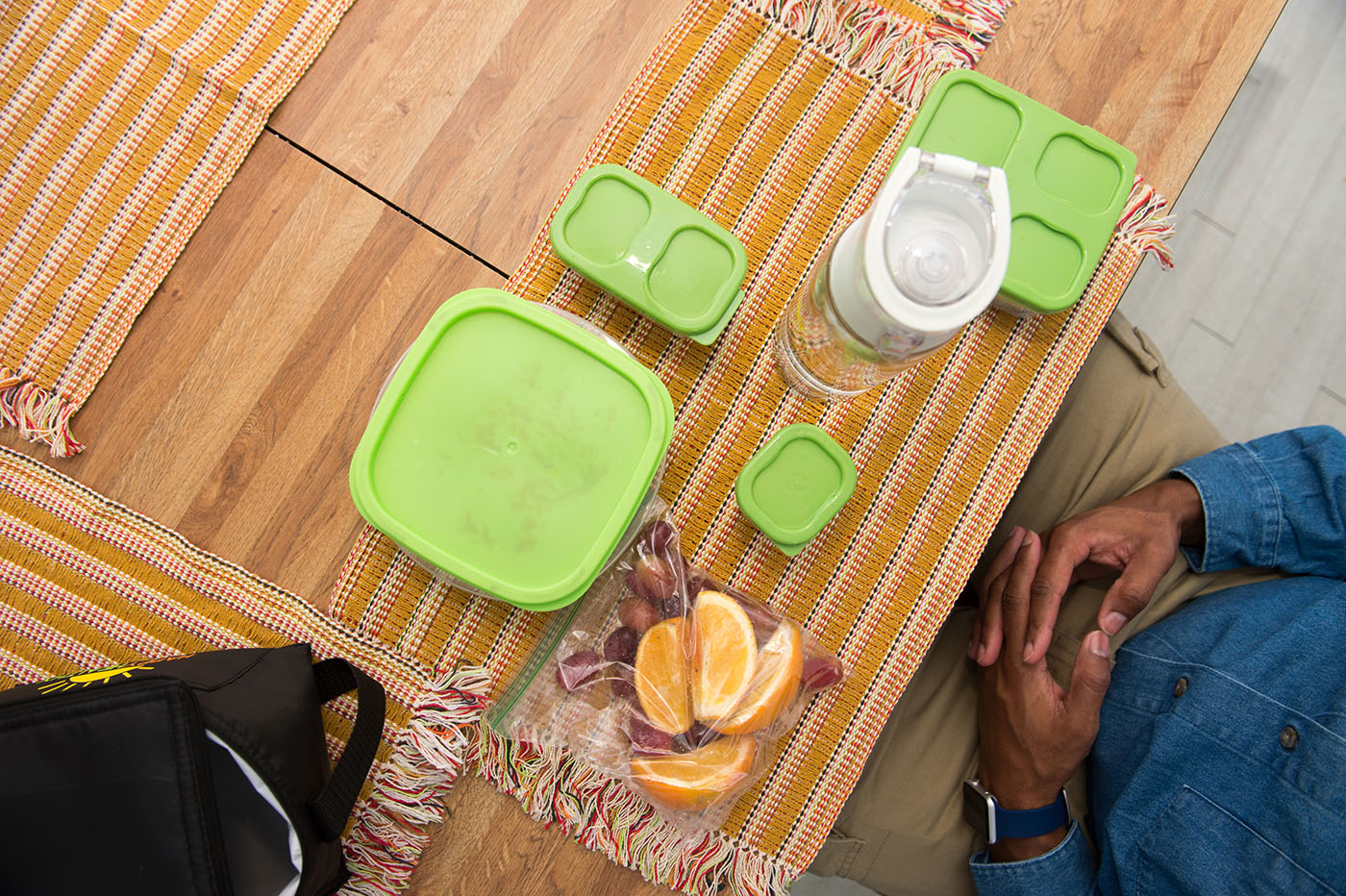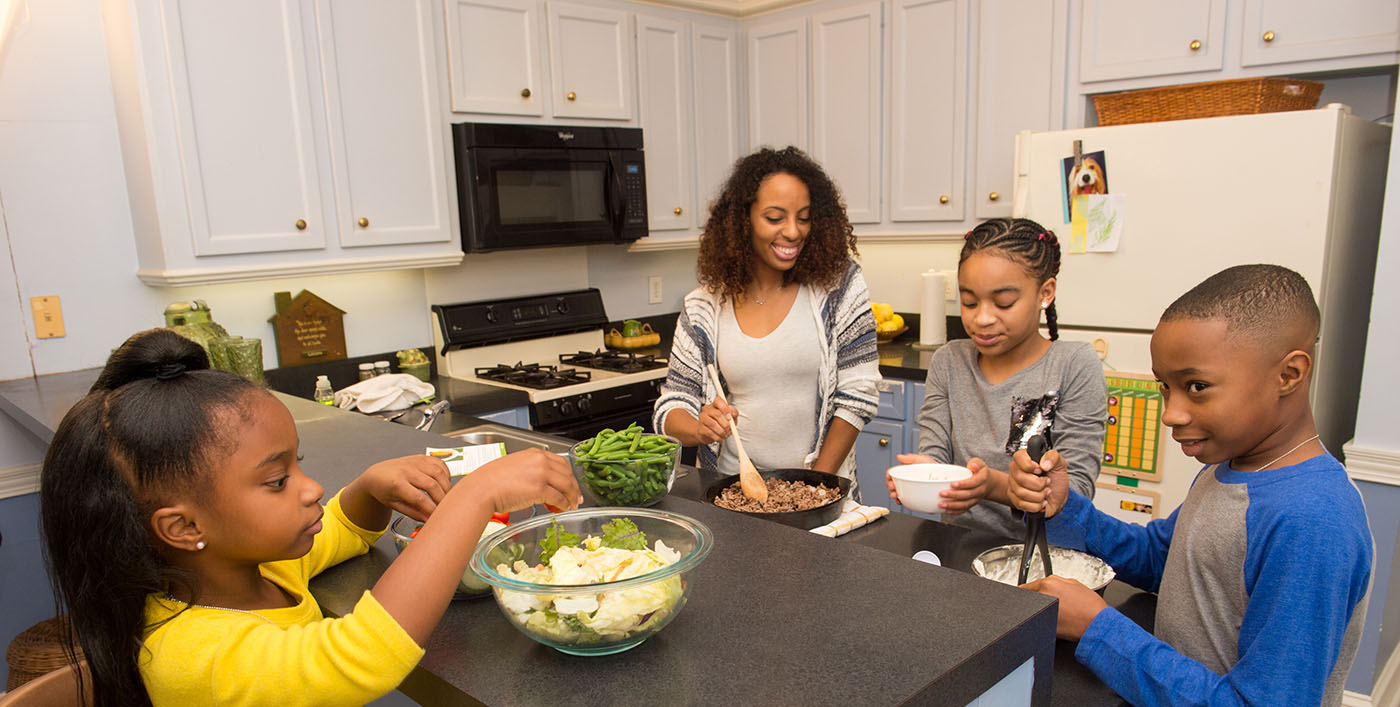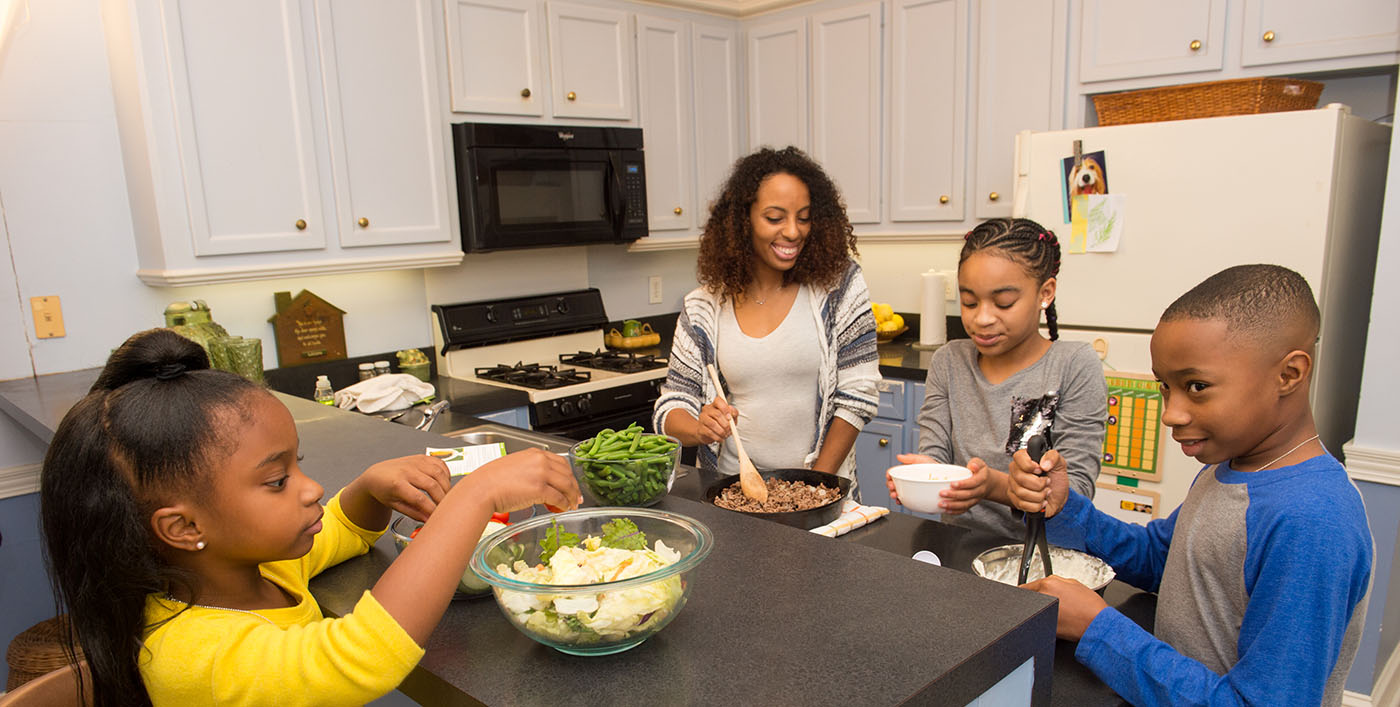Eating Together Matters

Research shows:
Kids who eat meals with their families are:
- 4 times less likely to smoke.
- 3 times less likely to use marijuana.
- 2 times less likely to drink alcohol.
Better Grades
Studies show that kids from elementary school to high school who ate dinner with their families more than 4 times a week had better test scores. Young children and babies who listened to parents around the table improved their language skills, too.
Healthier Bodies
In addition to limiting TV time and getting enough sleep, kids who eat meals with family members are more confident and stay at a healthy weight.
Tips for Family Meals
Your kids learn from you. Your children watch what you do. At the table, if your kids see you enjoying a healthy meal, they will follow in your footsteps. So choose healthy!
Conversation time. Because everyone gathers together, meal times are the perfect times to sit down and talk as a family. Remember to talk positively, but honestly. Discuss problems at some other place and time.
No electronics. Televisions, phones, tablets, and computers are a real distraction from quality time with the family. Meal times should encourage person-to-person conversation.
Get your family involved. Everyone should be a part of meal time. Let everyone participate in shopping for groceries, cooking, eating, and cleaning up afterwards!
Choices. You shouldn’t have to cook around picky eaters, but you can give kids options between which fruits or vegetables they would like. This will make them more willing to eat what they’ve chosen.
Make the healthy choice, the easy choice. Keep fresh fruit and vegetables on hand and within reach as healthy and delicious snacks. If your family eats healthy, so will your kids.
Enjoy. Food isn’t the only thing to enjoy at meals. Eating meals together helps to improve family connections. Savor every moment and every delicious bite!
Breakfast Together

BREAKFAST IS IMPORTANT
SOME THINGS ARE JUST BETTER TOGETHER. LIKE BREAKFAST.
IT HELPS KIDS GROW, LEARN, AND PLAY.
Better Breakfast Tips:
- Start small. Eating together once or twice a week makes a difference.
- Add fruit. Choose fresh fruit in season, frozen, or canned in water or juice.
- Choose milk. Plain, low-fat (1%) milk is best for children over age two.
- Save time. Get ready for morning. Make breakfast the night before.
Breakfast Together
Why Breakfast Matters
Breakfast is the most important meal of the day, especially for children and teenagers.
Children who eat breakfast do better in school and feel better throughout the day.
Sitting down with your children helps them feel confident and connect with you.
Weekends (or days that you and your family are free) are good times have breakfast together.
How to Start
- Baby steps. Don’t expect your family to start eating breakfast together every day. Start out with a small goal—once or twice a week—and move up from there.
- Simple is good. Breakfast doesn’t have to be gourmet. Something as easy as oatmeal can be made ahead of time, reheated, and eaten together as a family.
- Time to relax. Meals are a good time to get away from distractions like TV, phones, and video games. Take time to relax in the morning with your family before you start your day.
- Get involved. Let your family get involved with shopping, cooking, and cleaning. This will give your family more time to bond. Being a part of food decisions will also make your family more willing to eat together and enjoy it.
- Table Talk. Meals should be a time for your family to relax and bond. Problems should be discussed away from the table.
Breakfast Five by Five

Breakfast Five by Five
Here is a 5-by-5 take on quick ways to get the day off to a great start for yourself or your whole family!
Toast FIVE Ways
- Bite into whole-grain toast topped with peanut butter, a spoonful of honey, and fruit that is on sale. Instead of bread, you can toast a whole-wheat waffle.
- Try low-fat cottage cheese instead of cream cheese on your toast. Drizzle jelly and a handful of your favorite nuts on top. Add a piece of fruit on the side.
- Make a breakfast pizza! On a tortilla, pile a handful of your favorites from this list: tomato sauce (or fresh/canned tomato slices), cheese, onions, lettuce, peppers, mushrooms, beans, or salsa. Melt everything on top in the microwave or toaster oven.
- Top a slice of toast with three big spoonfuls of low-fat cottage cheese, a tomato slice, a couple of avocado slices, and a pinch of salt and pepper.
- Try mashed bananas on toast. Just mash ½ banana with a fork, and spoon it on a toasted English muffin. As a side, have string cheese or a hard-boiled egg.
Oatmeal FIVE ways
- Slice half a banana for your oatmeal. When cooked, it makes your oatmeal grow into a bigger portion without a lot of extra calories. Because of the fruit’s sweetness, add less sugar. Add a teaspoon each of vanilla extract and cinnamon to boost the flavor.
- Cook oatmeal in water. Afterwards, add two big spoonfuls of low-fat, plain yogurt with a pinch of cinnamon.
- In-season fruits are less expensive. Find them under “sale” signs at your grocery store. Frozen and canned fruits (in water or own juice) are good all year long! Put these fruits in your oatmeal.
- For PB&J oatmeal, mix in a spoonful of nuts and a spoonful of jelly.
- If you’re making pancakes, mix oats into your batter.
Eggs FIVE ways
- Scramble eggs with spinach (fresh, frozen, or canned) and onions with fruit as a side. If using frozen spinach, thaw it and squeeze the water out first!
- Sandwich a fried or poached egg between a whole-wheat English Muffin. Stack on vegetables and a slice of cheese.
- Brown-shelled eggs are no better for you than white-shelled eggs. Stick to the cheaper variety and buy extra veggies to add to a burrito. If you don’t have fresh veggies on hand, scramble your eggs with salsa. Scoop it all into a tortilla.
- Leftover veggies from yesterday’s dinner? Heat them in a skillet and top them with two eggs and a spoonful of cheese. Then, spice up your dish with herbs or salsa.
- Mix eggs into your batter for pancakes, muffins, or French toast.
Fruit FIVE ways
- Look for price mark-downs on fresh fruits. These fruits will cost less during the months they are in season: citrus fruits will be cheaper in the winter, berries in the spring and summer, and apples in the fall.
- Frozen fruits are always cheap. Find them in the frozen foods section in the grocery store. When you’re ready to eat them, thaw the fruit on the counter, in the microwave, or in the refrigerator. Use them as a topping for pancakes, waffles, or cereal.
- At a farmer’s market, ask for “seconds.” These fruits are cheaper because they are mildly bruised or marked. Peel off the discolored parts and mix what’s left with low-fat plain yogurt. Add a spoonful of sugar, nuts, and a pinch of cinnamon.
- Cut fruit into small pieces for dipping into peanut butter, yogurt, or low-fat whipped cream! Buying pre-cut fruit is expensive.
- Make an edible bowl! Slice a small cantaloupe in half. Scoop out the seeds. Scoop in low-fat cottage cheese, cereal, and a spoonful of sugar.
Vegetables FIVE ways
- Sauté onions with sweet potato pieces. “Sauté” means using a spoonful or two of oil, butter, or another fat to cook your food in a skillet over medium heat on the stovetop.
- Keep the skins on your potatoes and slice them very thin. Sauté them with onions, garlic, and peppers.
- Fill an omelet with frozen or leftover vegetables.
- A quesadilla for breakfast? Try a six-inch whole-wheat tortilla stuffed with cheese and vegetables.
- Mix chopped, cooked veggies into your scrambled eggs. Top with a spoonful of grated cheese.
Snacks Together

Eat Snacks Together
Not everyone can eat a family meal around a table three times a day.
If you can’t squeeze in mealtime, fit in some snacks!
It doesn’t have to be fancy as long as you eat together!
HOW TO START
Go slowly. Try to snack together once or twice a week in the beginning.
Start simple. Preparing healthy snacks ahead of time can save you time. Store snacks until you’re ready to eat.
No electronics. Turning off all electronics will create a calm atmosphere for your family’s meal.
Get everyone involved. Let your family help you shop, choose their favorite healthy snack, set the table, or make the snack.
Relax and connect. Enjoy healthy foods while connecting with your family and friends.
THEY LEARN FROM WATCHING YOU.
Simply Healthy Combos

SIMPLY HEALTHY COMBOS
GRAPES WITH PB YOGURT DIP
Dip grapes in one cup low-fat vanilla yogurt mixed with a spoonful of peanut butter.
PRETZELS-N-CHEESE WITH DIP
Dip a handful of pretzels in honey mustard and add string cheese.
CHIPS WITH BLACK BEAN SALSA
Dip a handful of tortilla chips in salsa with black beans mixed in.
SOME THINGS ARE JUST BETTER TOGETHER. LIKE MAKING SIMPLE SNACKS.
GRAHAM CRACKER “CHEESECAKE”
Top a graham cracker with two spoonfuls of cottage cheese and a little jelly.
CHILI DUSTED MANGO
Top mango slices with a squeeze of lime juice and a pinch of chili powder.
BANANA SANDWICHES
Top banana slices with peanut butter and raisins.
SNACKS + YOU = SMILES
ANTS ON A LOG
5 stalks celery
½ cup peanut butter
¼ cup raisins
- Wash celery stalks
- Cut them in half
- Spread with peanut butter
- Sprinkle with raisins
MORE GREAT RECIPES
Lady Bugs on a Log
Cream cheese with dried cranberries or grapes.
Bumble Bees on a Log
Peanut butter with yellow raisins and chocolate chips.
Bugs Go to the Zoo
Yogurt with animal crackers.
Snack Tips for Parents

Snack Tips for Parents
Snacks can help children get the nutrients needed to grow. Prepare snacks that include two or more food groups. For younger children, help them get just enough to satisfy their hunger. Let older kids make their own snacks by keeping healthy foods in the kitchen. Visit ChooseMyPlate.gove to help you and your kids select a satisfying snack.
- Save time by slicing veggies
- Store sliced vegetables in the refrigerator and serve with hummus. Top half of a whole-wheat English muffin with spaghetti sauce, chopped vegetables, and low-fat shredded mozzarella and melt in the microwave.
- Mix it up
- For older school-age kids, mix dried fruit, unsalted nuts, and popcorn in a snack-size bag for a quick trail mix. Put fat-free yogurt, 100% fruit juice, and frozen peaches in a blender to make a tasty smoothie.
- Grab a glass of milk
- A cup of low-fat milk or fortified soy beverage is an easy way to drink a healthy snack.
- Go for great whole grains
- Offer whole-wheat breads, popcorn, and whole-oat cereals that are high in fiber and low in added sugars, saturated fat, and sodium. Limit refined-grain products such as snack bars, cakes, and sweetened cereals.
- Snack on protein foods.
- Choose protein foods such as unsalted nuts and seeds, hummus or other bean dips, and hard-cooked (boiled) eggs for a healthy, easy snack. Store hard-cooked eggs in the refrigerator for up to 1 week for kids to enjoy any time.
- Keep an eye on the size.
- Snacks shouldn't replace a meal, so look for ways to help your kids understand how much is enough. Store snack-size bags in the cupboard and use them to control serving sizes.
- Fruits are quick and easy.
- Fresh, frozen, dried, or canned fruits, such as applesauce, frozen grapes, or raisins, can be easy "grab-and-go" options that need little preparation. Offer whole fruit and limit the amount of 100% juice served. Choose canned fruits that are packed in 100% juice.
- Consider convenience.
- A single-serving container of low-fat yogurt or individually wrapped string cheese can be just enough for an after-school snack.
- Swap out the sugar
- Keep healthier foods handy so kids avoid cookies, pastries, or candies between meals. Add seltzer water to a 1/2 cup of 100% fruit juice instead of offering soda.
- Prepare homemade goodies.
- For homemade sweets, add dried fruits like apricots or raisins and reduce the amount of sugar in the recipe. Adjust recipes that include fats like butter or shortening by using unsweetened applesauce or prune puree for half the amount of fat.
Brought to you by the United States Department of Agriculture. DG TipSheet No. 24, March 2013, Revised October 2016.
Dinner Together

Eat Dinner Together
Life is busy, but it is possible to eat together as a family.
Try fitting in dinner after work or sports practice.
To save time and help scheduling, try creating simple meals. You can even cook and freeze meals the weekend before or whenever you have time, and then heat them up for a quick and tasty meal during the week.
Dinner doesn’t have to be fancy. Eating together is what counts.
How to start
Go slowly. In the beginning, don’t expect your family to eat together every day. It will take time to develop this habit. Try setting a starting goal of one to two times per week.
Start simple. Cook meals ahead of time that you can freeze, reheat, and share with your family at your convenience.
A calm environment. Anything that can disrupt your meal (including electronics like phones, TVs, or video games) should be turned off and put away. Without these distractions, everyone will be more relaxed and concentrated on spending time together.
Involvement. Make sure everyone is involved in the meal process. This includes brainstorming, shopping, cooking, eating, and cleaning.
Relax and connect. Keep dinner conversation fun. Share any and all positive events of the day. Tell jokes and funny stories. Ask each other riddles. Encourage your kids to share things that make them laugh.
The Importance of Family Dinners

The Importance of Family Dinners
Fitting meals around an entire family’s busy schedule makes it hard to have “family dinners” together. However, family mealtime is extremely beneficial for children.
Research suggests that having dinner together four times a week has positive effects on child development. Family dinners have been linked to lower risk of obesity, substance abuse, eating disorders, and an increased chance of graduating from high school.
Conversation
Eating dinner with family provides time for conversation. Parents can teach healthy communication skills without distractions from smart phones, television, computers, or other electronic devices.
Engaging your children in conversation teaches them how to listen and gives them a chance to voice their opinions. This allows your children to have an active voice in the family.
Regular conversation at the dinner table expands a child’s vocabulary and reading ability, regardless of socioeconomic status. Family dinners also allow family members to discuss their day and share news.
- Use these tips to encourage conversation:
- Discuss your child’s day. Express interest in their daily life.
- Discuss current events. Bring up news that’s appropriate for your child’s age.
- Let all family members talk. Be an active listener and be sure your child learns to listen as well.
- Encourage your child to participate. Do not underestimate your child’s ability to hold a conversation.
Developmental Benefits
Family meals provide a sense of security and togetherness that help nurture children into healthy, well-rounded adults. Frequent family dinners have a positive impact on children’s values, motivation, personal identity, and self-esteem.
Children who eat dinner with their family are more likely to understand, acknowledge, and follow the boundaries and expectations set by their parents. A decrease in high-risk behaviors is related to a greater amount of time spent with family—especially during family dinners.
To make the most of your family mealtime, follow these guidelines:
- Turn off electronics during dinner.
- Try to have family dinners four to five times a week.
- Enjoy positive conversation during the meal.
- Spend an hour eating dinner, conversing, and cleaning up together.
Nutritional Benefits
Your children learn healthy eating habits from you; eating dinner together provides a model of healthy eating for children to take with them into adulthood. Studies show that families who eat together increase fruit and vegetable intake; they eat fewer fried foods and drink less soda; and family meal frequency is linked to the intake of protein, calcium, and some vitamins.
Mealtime suggestions:
- Cook as a family and include everyone in the preparation process.
- Experiment with fun recipes.
- Remake old recipes with healthier alternatives.
- Have “theme” cuisine nights such as Italian, Mexican, or Caribbean.
- Know your children’s favorite meals and cook them on a rotating basis.
- Create your own recipes.
Daily family dinners require effort to plan, but their benefits in mental and physical health are more than worth it.
Make Mealtime Family Time

Make Mealtime Family Time
Better Dinner Tips:
- Start early. Start eating meals together when your kids are young. Try to have a family meal a few times a week.
- Let them do it. Let your kids serve themselves at dinner. Teach them to take small amounts first. If they’re still hungry, then they can have more.
- Try something new. Try new foods, but don’t force your child to eat.
- Make time to talk. Focus on the meal and each other. Turn off the TV and take phone calls and texts later.